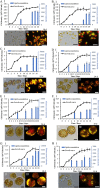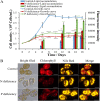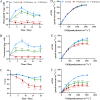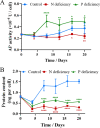Nutrient Deficiency and an Algicidal Bacterium Improved the Lipid Profiles of a Novel Promising Oleaginous Dinoflagellate, Prorocentrum donghaiense, for Biodiesel Production
- PMID: 34319787
- PMCID: PMC8436737
- DOI: 10.1128/AEM.01159-21
Nutrient Deficiency and an Algicidal Bacterium Improved the Lipid Profiles of a Novel Promising Oleaginous Dinoflagellate, Prorocentrum donghaiense, for Biodiesel Production
Abstract
The lipid production potentials of 8 microalgal species were investigated. Among these 8 species, the best strain was a dominant bloom-causing dinoflagellate, Prorocentrum donghaiense; this species had a lipid content of 49.32% ± 1.99% and exhibited a lipid productivity of 95.47 ± 0.99 mg liter-1 day-1, which was 2-fold higher than the corresponding values obtained for the oleaginous microalgae Nannochloropsis gaditana and Phaeodactylum tricornutum. P. donghaiense, which is enriched in C16:0 and C22:6, is appropriate for commercial docosahexaenoic acid (DHA) production. Nitrogen or phosphorus stress markedly induced lipid accumulation to levels surpassing 75% of the dry weight, increased the C18:0 and C17:1 contents, and decreased the C18:5 and C22:6 contents, and these effects resulted in decreases in the unsaturated fatty acid levels and changes in the lipid properties of P. donghaiense such that the species met the biodiesel specification standards. Compared with the results obtained under N-deficient conditions, the enhancement in the activity of alkaline phosphatase of P. donghaiense observed under P-deficient conditions partly alleviated the adverse effects on the photosynthetic system exerted by P deficiency to induce the production of more carbohydrates for lipogenesis. The supernatant of the algicidal bacterium Paracoccus sp. strain Y42 culture lysed P. donghaiense without decreasing its lipid content, which resulted in facilitation of the downstream oil extraction process and energy savings through the lysis of algal cells. The Y42 supernatant treatment improved the lipid profiles of algal cells by increasing their C16:0, C18:0, and C18:1 contents and decreasing their C18:5 and C22:6 contents, which is favorable for biodiesel production. IMPORTANCE This study demonstrates the high potential of Prorocentrum donghaiense, a dominant bloom-causing dinoflagellate, for lipid production. Compared with previously studied oleaginous microalgae, P. donghaiense exhibit greater potential for practical application due to its higher biomass and lipid contents. Nutrient deficiency and the algicidal bacterium Paracoccus sp. strain Y42 improved the suitability of the lipid profile of P. donghaiense for biodiesel production. Furthermore, Paracoccus sp. Y42 effectively lysed algal cells, which facilitates the downstream oil extraction process for biodiesel production and results in energy savings through the lysing of algal cells. This study provides a more promising candidate for the production of docosahexaenoic acid (DHA) for human nutritional products and of microalgal biofuel as well as a more cost-effective method for breaking algal cells. The high lipid productivity of P. donghaiense and algal cell lysis by algicidal bacteria contribute to reductions in the production cost of microalgal oil.
Keywords: DHA; Prorocentrum donghaiense; algicidal bacteria; biodiesel production; lipid accumulation; nutrient starvation.
Figures








Similar articles
-
Algicidal Activity of Novel Marine Bacterium Paracoccus sp. Strain Y42 against a Harmful Algal-Bloom-Causing Dinoflagellate, Prorocentrum donghaiense.Appl Environ Microbiol. 2018 Sep 17;84(19):e01015-18. doi: 10.1128/AEM.01015-18. Print 2018 Oct 1. Appl Environ Microbiol. 2018. PMID: 30054369 Free PMC article.
-
Effect and mechanism of the algicidal bacterium Sulfitobacter porphyrae ZFX1 on the mitigation of harmful algal blooms caused by Prorocentrum donghaiense.Environ Pollut. 2020 Aug;263(Pt A):114475. doi: 10.1016/j.envpol.2020.114475. Epub 2020 Apr 1. Environ Pollut. 2020. PMID: 33618477
-
Isolation of an algicidal bacterium and its effects against the harmful-algal- bloom dinoflagellate Prorocentrum donghaiense (Dinophyceae).Harmful Algae. 2018 Dec;80:72-79. doi: 10.1016/j.hal.2018.09.003. Epub 2018 Oct 6. Harmful Algae. 2018. PMID: 30502814
-
An overview of Prorocentrum donghaiense blooms in China: Species identification, occurrences, ecological consequences, and factors regulating prevalence.Harmful Algae. 2022 May;114:102207. doi: 10.1016/j.hal.2022.102207. Epub 2022 Feb 24. Harmful Algae. 2022. PMID: 35550289 Review.
-
Microalgal lipids biochemistry and biotechnological perspectives.Biotechnol Adv. 2014 Dec;32(8):1476-93. doi: 10.1016/j.biotechadv.2014.10.003. Epub 2014 Oct 14. Biotechnol Adv. 2014. PMID: 25449285 Review.
Cited by
-
Microalgae biofuels: illuminating the path to a sustainable future amidst challenges and opportunities.Biotechnol Biofuels Bioprod. 2024 Jan 23;17(1):10. doi: 10.1186/s13068-024-02461-0. Biotechnol Biofuels Bioprod. 2024. PMID: 38254224 Free PMC article. Review.
-
Chronological age-related metabolome responses in the dinoflagellate Karenia mikimotoi, can predict future bloom demise.Commun Biol. 2023 Mar 15;6(1):273. doi: 10.1038/s42003-023-04646-z. Commun Biol. 2023. PMID: 36922623 Free PMC article.
-
Algicidal Bacteria: A Review of Current Knowledge and Applications to Control Harmful Algal Blooms.Front Microbiol. 2022 Apr 7;13:871177. doi: 10.3389/fmicb.2022.871177. eCollection 2022. Front Microbiol. 2022. PMID: 35464927 Free PMC article. Review.
-
Comparison of Lipid Content in Nine Dinoflagellate Species Using Flow Cytometry.Microorganisms. 2024 Dec 30;13(1):44. doi: 10.3390/microorganisms13010044. Microorganisms. 2024. PMID: 39858812 Free PMC article.
-
OMICS Approaches to Assess Dinoflagellate Responses to Chemical Stressors.Biology (Basel). 2023 Sep 13;12(9):1234. doi: 10.3390/biology12091234. Biology (Basel). 2023. PMID: 37759633 Free PMC article. Review.
References
-
- Borowitzka MA. 1995. Microalgae as sources of pharmaceuticals and other biologically active compounds. J Appl Phycol 7:3–15. 10.1007/BF00003544. - DOI
-
- Milano J, Ong HW, Masjuki HH, Chong WT, Lam MK, Loh PK, Vellayan V. 2016. Microalgae biofuels as an alternative to fossil fuel for power generation. Renew Sustain Energy Rev 58:180–197. 10.1016/j.rser.2015.12.150. - DOI
Publication types
MeSH terms
Substances
LinkOut - more resources
Full Text Sources
Miscellaneous

